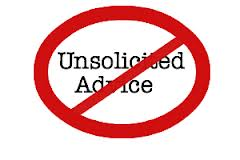When we discover something new, or see someone we know in pain, or struggling with a problem, we want to help, to solve the problem. And off we go, giving advice. And, more often than not, that advice is received with resistance. “How can that be?”, we ask, “I genuinely wanted to help, and I am sensing my advice is not being well received”.
Here are some examples I have experienced lately, perhaps you can name one or two of your own:
- I was watching my partner try and figure out how to do something on his Ipad. He didn’t ask for help, but there I was offering a “better way”; just wanting to save him time I said…
- A friend found a new exercise program for his back, and instead of simply sharing his happiness with the results, he was working really hard to convince me to agree to try it (even though I reminded him I have one I use).
- A colleague and I were discussing best practices, sharing ideas and then, without asking, I received a series of emails offering advice.
Offering unsolicited advice is the opposite of asking the better question. So, next time you are tempted to give advice, don’t. Wait until you are asked. And if you must say something, consider asking a question.




















 The initial results of my Pivot are excellent. I feel I have much greater clarity regarding the next 3-5 years..
The initial results of my Pivot are excellent. I feel I have much greater clarity regarding the next 3-5 years..  John Yerger
John Yerger